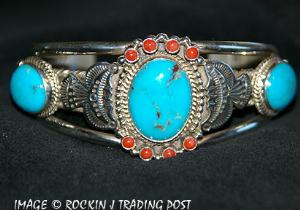

(505)862-8747
A Few Facts About Turquoise
Turquoise is one of the most valuable and highly sought after minerals in the jewelry trade, today. Jewelry made from Turquoise has been worn for thousands of years by people all over the world. The stone has been valued and used for both it's spiritual values and healing values via the metaphysical realm since as far back as 5500 B.C. It has been used in Native American jewelry since about 1880 and has been mined since atleast 6000 B.C. The finest Turquoise is mined in Iran, however there are many mines in the Southwestern United States that rival the quality and beauty of Iranian Turquoise. Some of the more notable sources of American Turquoise are in Arizona, New Mexico and Nevada although mines are present in most of the Southwestern states. Turquoise is also mined in Australia, China, Iran, Afghanistan and other places in the Middle East.
Since turquoise is such a valuable gemstone, there have been plenty of people try to fake the beauty of real turquoise. Some of the ways this is done is by dying of other stones--such as howlite, re-creating it in plastic or by heating, gluing and pressing turquoise shavings (from stone cutting) together (known as "block" or "reconstituted" turquoise), and even a porcelain version of "turquoise." A type of jasper found in Africa is often dyed to look more like turquoise and represented as such. A few minerals often used as gemstones that are commonly mistaken for turquoise include azurite, malachite and amazonite, Although many of these "knock-offs" look like real turquoise, it is obvious to a trained eye that they are nowhere near the quality of real turquoise. Sadly, many people have taken advantage of today's consumer by passing off fake turquoise as the real thing.
Turquoise comes in a variety of colors ranging from pale blue to mint green, bright blue to kelly green and most shades in between. The blue shades are the ones most commonly thought of when the term "turquoise" is used. These stones come from a copper-rich environment. Green shades of turquoise are most commonly found when there as a lot of iron present. The yellow or yellowish-green shades of turquoise are caused by zinc. Yellow-Green turquoise is one of the most rare varieties and only found in a few mines.
The matrix in turquoise is one of the things that makes each stone unique. The matrix in turquoise is basically left-over pieces of the rock that housed it before it was mined. To some cultures, matrix makes a stone more beautiful, but others see it as a flaw in the stone and value it less. Matrix comes in many colors, depending on where the stone was found. Black matrix is one of the most common and most favored as it adds nice contrast. Black matrix is most commonly from iron pyrite. Yellow and brown are the other two common colors for turquoise matrix. The yellow is found in turquoise that was removed from volcanic rock and the brown is usually seen caused by iron oxide.
Turquoise is a very valued, very beautiful stone that is in short supply in the United States. Less than 20% of the Turquoise mined today comes from the United States and many of the mines have been shut down. This makes American Turquoise very valuable and very sought after. Some of the more notable mines and turquoise are the Blue Gem mine near Battle Mountain, NV (now closed), the Kingman mine in northern Arizona, the Bisbee Mine near Bisbee, AZ, Morenci Turquoise from southeastern Arizona, the Number 8 mine in Carlin, NV, Pilot Mountain in Western Nevada, Royston Turquoise from southwestern Nevada and Sleeping Beauty just outside of Globe, Arizona.
Some sites with excellent representations of the colors of turquoise and more information turquoise can be found below:
skystonetrading.com
durangosilver.com
indianvillage.com
turquoisejewelry.com
turquoisefacts.com